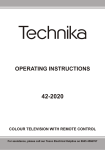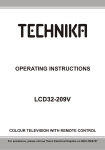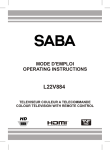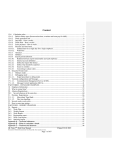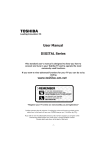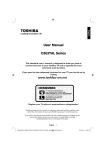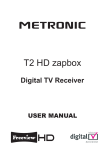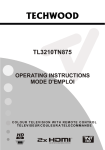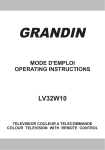Download Technika_42_2030_en - Tesco Tech Support
Transcript
OPERATING INSTRUCTIONS Colour Television with Remote Control 42-2030 *4HD not in Wales. Clirlun, S4C’s High Definition Channel, in Wales only. The FREEVIEW service is subject to coverage. An aerial upgrade may be required. The FREEVIEW, FREEVIEW+, FREEVIEW HD and FREEVIEW+ HD words and logos are trade marks of DTV Services LTD. © DTV Services Ltd 2010. Channels subject to change. The channel logos are trademarks and copyright of their respective owners. CHECK YOUR HD COVERAGE online at freeview.co.uk or text your postcode followed by your house number or name to 80560 (e.g. NW9 6NY 1) Costs no more than a normal text. For assistance, please call our Tesco Electrical Helpline on 0845 4566767 〰彔䕃䡎䥋䄠䍏噅删⡙䕎䤠䱏䝏⥟弱〰㘸㔳㝟㔰ㄶ㜱㘵 ㄷ⁈慺楲慮′〱〠健狾敭扥‱ㄺ㔴㨱 50167165 〰彔䕃䡎䥋䄠䍏噅删⡙䕎䤠䱏䝏⥟弱〰㘸㔳㝟㔰ㄶ㜱㘵 ㄷ⁈慺楲慮′〱〠健狾敭扥‱ㄺ㔴㨱 )UHHYLHZ+'FRYHUDJHUROORXW 7KHIROORZLQJPDSVJLYHDQLQGLFDWLRQRIWKHLQFUHDVLQJSHUFHQWDJHRI8.KRXVHKROGV DEOHWRDFFHVV)UHHYLHZ+'DVWKHWUDQVPLVVLRQQHWZRUNXSJUDGHSURJUHVVHVWR -XO\RI8.KRXVHKROGV &URZQFRS\ULJKWDQG GDWDEDVHULJKW$OOULJKWV UHVHUYHG2UGQDQFH6XUYH\ /LFHQFHQXPEHU (QGRIRI8.KRXVHKROGV &URZQFRS\ULJKWDQG GDWDEDVHULJKW$OOULJKWV UHVHUYHG2UGQDQFH6XUYH\ /LFHQFHQXPEHU Please note that the maps are only indicative of the areas in which Freeview HD will be available as the transmission network upgrade progresses. For detailed coverage information associated with specific dates, the postcode checker database should be used. English - 1 A01_MB38_[GB]_3902UK_IDTV-T2_GOLD7_42884W_10068537_50167165.indd 1 17.06.2010 13:09:57 (QGRIRI8.KRXVHKROGV &URZQFRS\ULJKWDQG GDWDEDVHULJKW$OOULJKWV UHVHUYHG2UGQDQFH6XUYH\ /LFHQFHQXPEHU (QGRI'62LQRI8.KRXVHKROGV &URZQFRS\ULJKWDQG GDWDEDVHULJKW$OOULJKWV UHVHUYHG2UGQDQFH6XUYH\ /LFHQFHQXPEHU English - 2 A01_MB38_[GB]_3902UK_IDTV-T2_GOLD7_42884W_10068537_50167165.indd 2 17.06.2010 13:09:59 Contents Features ................................................................. 4 Introduction ............................................................. 4 Package Contents .................................................. 4 Preparation ............................................................. 5 Safety Precautions ................................................. 5 Power Source ..................................................... 5 Power Cord ......................................................... 5 Moisture and Water ............................................ 5 Cleaning.............................................................. 5 Heat and Flames ................................................ 5 Lightning ............................................................. 5 Replacement Parts ............................................. 5 Servicing ............................................................. 5 Waste Disposal ................................................... 5 Information for Users in European Union Countries ............................................................ 6 Disconnecting the Device ................................... 6 Headphone Volume ............................................ 6 Installation........................................................... 6 LCD Screen ........................................................ 6 Warning .............................................................. 6 Inserting Batteries in the Remote Control............... 7 Switching the TV On/Off ......................................... 7 To Switch the TV On ........................................... 7 To Switch the TV Off ........................................... 7 Environmental Information ..................................... 7 Overview of the Remote Control ............................ 8 LCD TV and Operating Buttons .............................. 9 Viewing the Connections- Back Connectors .......... 9 Viewing the Connections - Side Connectors .........11 Power Connection .................................................11 Aerial Connection ..................................................11 Using USB Input ................................................... 12 USB Memory Connection ................................. 12 Connecting the LCD TV to a PC........................... 12 Connecting to a DVD Player................................. 13 Using Side AV Connectors ................................... 13 Connecting Other Equipment via Scart ................ 13 Input Selection ...................................................... 14 Basic Operations .................................................. 14 Operation with the Buttons of the TV ................ 14 Operation with the Remote Control .................. 14 Initial Settings ....................................................... 14 General Operation ................................................ 15 Electronic Programme Guide (EPG)................. 15 Programme Options.......................................... 16 Analogue Teletext ............................................. 16 Widescreen ....................................................... 16 IDTV Menu System .............................................. 17 Channel List ...................................................... 17 Navigating the Entire Channel List ................... 17 Moving the channels in the channel list ............ 17 Deleting the Channels in the Channel List ....... 17 Renaming channels .......................................... 17 Adding Locks to Channels ................................ 17 Setting Favourites ............................................. 18 Program Guide ................................................. 18 Common Interface ........................................... 18 TV Setup ........................................................... 18 Setup ................................................................ 19 Configuration .................................................... 19 Language Settings ............................................ 20 Installation......................................................... 21 Analogue TV Menu System .................................. 22 Picture Menu..................................................... 22 Sound Menu ..................................................... 23 Feature Menu ................................................... 24 Install Menu ...................................................... 25 Source Menu .................................................... 26 Media Browser Menu............................................ 26 Playing .mp3 Files ............................................ 27 Playing .jpg Files............................................... 27 PC Mode Menu System........................................ 27 PC Position Menu ............................................. 27 Displaying TV Information .................................... 28 Mute Function ....................................................... 28 Picture Mode Selection......................................... 28 Freezing Picture ................................................... 28 Zoom Modes......................................................... 28 Auto .................................................................. 28 16:9 ................................................................... 28 4:3 ..................................................................... 28 Panoramic......................................................... 28 14:9 ................................................................... 28 Cinema ............................................................. 29 Subtitle .............................................................. 29 Zoom................................................................. 29 Teletext ................................................................. 29 Tips ....................................................................... 30 Screen Care...................................................... 30 Image Persistence ............................................ 30 No Power .......................................................... 30 Poor Picture ...................................................... 30 No Picture ......................................................... 30 Sound ............................................................... 30 Remote Control................................................. 30 Input Sources.................................................... 30 Appendix A: PC Input Typical Display Modes....... 31 Appendix B: AV and HDMI Signal Compatibility (Input Signal Types).............................................. 32 Appendix C: Supported File Formats for USB Mode 33 Appendix D: Supported DVI Resolutions.............. 33 Specifications ....................................................... 34 Digital Reception (DVB-T) .................................... 34 Digital Reception (DVB-T2) .................................. 34 Important Instruction ............................................. 35 English - 3 A01_MB38_[GB]_3902UK_IDTV-T2_GOLD7_42884W_10068537_50167165.indd 3 17.06.2010 13:10:00 Features • Remote controlled colour LCD TV. • Fully integrated digital TV (DVB-T DVB-T2 - MPEG2 MPEG4). • DTV input supports 1920x1080i • HDMI connectors for digital video and audio. This connection is also designed to accept high definition signals. • USB input. • 200 programmes from VHF, UHF(analogue). • 1000 programmes for digital mode (IDTV). • Integrated tuner DVB-T HD, MPEG 2 / MPEG 4 compatible. • OSD menu system. • Two scart sockets for external devices (such as video, video games, audio set, etc.). • Stereo sound system. (German+Nicam) • Teletext, fastext, TOP text. • Headphone connection. • Automatic programming system. • Forward or backward manual tuning. • Automatic sound mute when no transmission. • NTSC playback. • AVL (Automatic Volume Limiting). • When no valid signal is detected, after 5 minutes the TV switches itself automatically to standby mode. • PLL (Frequency Search). • PC input. • Plug&Play for Windows 98, ME, 2000, XP, Vista, Windows 7. • Audio line out. • Game Mode recorder, VCR, PC etc.). This device is only suitable for the operation in dry interiors. This appliance is intended solely for private domestic use and may not be used for industrial and commercial purposes. We exclude liability in principle, if the device is not used as intended, or unauthorized modifications have been made. To operate your LCD-TV in extreme ambient conditions may cause the damage of the device. Package Contents SCREEN LANG 1 2 5 SUBTITLE PIP 3 4 6 7 8 9 0 Batteries: 2 X AAA RETURN MENU OK SOURCE FAV PRESETS SLEEP V+ P+ ? INFO EPG V- P- Instruction Book Remote Control Introduction Thank you for choosing this product. This manual will guide you for the proper operation of your TV. Before operating the TV, please read this manual thoroughly. LCD TV Note: You should check the accessories after purchasing. Make sure that each accessory is included. Please do keep this manual in a safe place for future references. Read the corresponding instructions of this handbook prior to the first usage of the device, even when the usage of electronic devices is familiar to you. Notice especially the chapter SAFETY PRECAUTIONS. Carefully keep the handbook as future reference. When selling the device or giving it away, absolutely give these direction for use. • This device is intended to receive and display TV programs. The different connection options make an additional expansion of the reception and display sources possible (receiver, DVD player, DVD English - 4 - A01_MB38_[GB]_3902UK_IDTV-T2_GOLD7_42884W_10068537_50167165.indd 4 17.06.2010 13:10:00 Preparation Cleaning For ventilation, leave a free space of at least 10 cm all around the set. To prevent any fault and unsafe situations, please do not place any objects on top of the set. Before cleaning, unplug the TV set from the wall outlet. Do not use liquid or aerosol cleaners. Use soft and dry cloth. Use this device in moderate climates. The slots and openings on the TV set are intended for ventilation and to ensure reliable operation. To prevent overheating, these openings must not be blocked or covered in anyway. 10 cm 10 cm 10 cm Ventilation Heat and Flames The set should not be placed near to open flames and sources of intense heat such as an electric heater. Ensure that no open flame sources, such as lighted candles, are placed on top of the TV. Batteries should not be exposed to excessive heat such as sunshine, fire or the like. Safety Precautions Please read the following recommended safety precautions carefully for your safety. Power Source The TV set should be operated only from a 220-240 V AC, 50 Hz outlet. Ensure that you select the correct voltage setting for your convenience. Power Cord Do not place the set, a piece of furniture, etc. on the power cord (mains lead) or pinch the cord. Handle the power cord by the plug. Do not unplug the appliance by pulling from the power cord and never touch the power cord with wet hands as this could cause a short circuit or electric shock. Never make a knot in the cord or tie it with other cords. The power cords should be placed in such a way that they are not likely to be stepped on. A damaged power cord can cause fire or give you an electric shock. When it is damaged and needs to be replaced, it should be done by qualified personnel. Moisture and Water Do not use this device in a humid and damp place (avoid the bathroom, the sink in the kitchen, and near the washing machine). Do not expose this device to rain or water, as this may be dangerous and do not place objects filled with liquids, such as flower vases, on top. Avoid from dripping or splashing. If any solid object or liquid falls into the cabinet, unplug the TV and have it checked by qualified personnel before operating it any further. Lightning In case of storm and lightning or when going on holiday, disconnect the power cord from the wall outlet. Replacement Parts When replacement parts are required, make sure that the service technician has used replacement parts, which are specified by the manufacturer or have the same specifications as the original one. Unauthorized substitutions may result in fire, electrical shock or other hazards. Servicing Please refer all servicing to qualified personnel. Do not remove the cover yourself as this may result in an electric shock. Waste Disposal Instructions for waste disposal: • Packaging and packaging aids are recyclable and should principally be recycled. Packaging materials, such as foil bag, must be kept away from children. • Batteries, including those which are heavy metalfree, should not be disposed of with household waste. Please dispose of used battery in an environment friendly manner. Find out about the legal regulations which apply in your area. Don’t try to recharge batteries. Danger of explosion. Replace batteries only with the same or equivalent type. • Cold cathode fluorescent lamp in LCD PANEL contains a small amount of mercury; please follow the local laws or regulations for disposal. English - 5 A01_MB38_[GB]_3902UK_IDTV-T2_GOLD7_42884W_10068537_50167165.indd 5 17.06.2010 13:10:00 Information for Users in European Union Countries This symbol on the product or on its packaging means that your electrical and electronic device should be disposed at the end of its service life separately from your household wastes. There are separate collection systems for recycling in EU. Electrical device not in the hands of children Never let children use electrical device unsupervised. Children can´t always recognize properly the possible dangers. Batteries / accumulators can be life threatening when swallowed. Store batteries unreachable for small children. In case of swallowing a battery medical aid has to be sought immediately. Also keep the packaging foils away from children. There is danger of suffocation. For more information, please contact the local authority or the dealer where you purchased the product. Disconnecting the Device The mains plug is used to disconnect TV set from the mains and therefore it must remain readily operable. Headphone Volume Excessive sound pressure from earphones and headphones can cause hearing loss. LICENSE NOTICE Installation To prevent injury, this device must be securely attached to the wall in accordance with the installation instructions when mounted to the wall (if the option is available). Manufactured under license from Dolby Laboratories. TRADEMARK ACKNOWLEDGMENT “Dolby” and the double-D symbol are trademarks of Dolby Laboratories. LCD Screen The LCD panel is a very high technology product with about a million thin film transistors, giving you fine picture details. Occasionally, a few non-active pixels may appear on the screen as a fixed blue, green or red point. Please note that this does not affect the performance of your product. Warning Do not leave your TV in standby or operating mode when you leave your house. •The Standby / On button doesn´t separate this device completely from mains. Moreover the device consumes power in the standby operation. In order to separate the device completely from mains, the mains plug has to be pulled from the mains socket. Because of that the device should be set up in a way, that an unobstructed access to mains socket is guaranteed, so that in case of emergency the mains plug can be pulled immediately. To exclude the danger of fire, the power cord should principally be separated from the mains socket prior to a longer period of non-usage, i.e. during vacations. English - 6 - A01_MB38_[GB]_3902UK_IDTV-T2_GOLD7_42884W_10068537_50167165.indd 6 17.06.2010 13:10:01 Inserting Batteries in the Remote Control Environmental Information • Remove the battery cover located on the back of the remote control by gently pulling backwards from the indicated part. • Insert two AAA/R3 or equivalent type batteries inside. Please ensure the correct polarity is observed. + - -+ Note: Remove the battery from remote control when it is not to be used for a long period. Otherwise it can be damaged due to any leakage of batteries. Remote range is approximately 7m/23ft. Switching the TV On/Off To Switch the TV On • Connect the power cord to the 220-240V AC 50 Hz. Then the standby LED lights up. • To switch on the TV from standby mode either: • Press the “ ” button, P+ / P- or a numeric button on the remote control. • Press the -P/CH or P/CH+ button on the TV. The TV will then switch on. Note: If you switch on your TV via PROGRAMME UP/DOWN buttons on the remote control or on the TV set, the programme that you were watching last will be reselected. By either method the TV will switch on. To Switch the TV Off • This television is designed to consume less energy to save environment. You not only help to save the environment but also you can save money by reducing electricity bills thanks to the energy efficiency feauture of this TV. To reduce energy consumption, you should take the following steps: • You can use Power Save Mode setting, located in the Feature menu. If you set Power Save Mode as On, the TV will switch to energy-saving mode and luminance level of TV set will be decreased to optimum level. Note that some picture settings will be unavailable to be changed when the TV is in Power Save Mode. • When the TV is not in use, please switch off or disconnect the TV from the mains plug. This will also reduce energy consumption. • Disconnect power when going away for longer time. • Note that annually, using the TV set in Power Save Mode has more power efficiency than disconnecting the TV from the mains plug instead of keeping stand-by mode. Therefore disconnect the TV from the mains plug to save energy when you do not use. However it is highly recommended to activate Power Save Mode setting to reduce your annual power consumption. • Please helps us to save environment by following these steps. Repair Information Please refer all servicing to qualified personnel. Only qualified personnel must repair the TV. Please contact your local dealer, where you have purchased this TV for further information. • Press the “ ” button on the remote control or press the “ ” switch on the TV, so the TV will switch to standby mode. • To power down the TV completely, unplug the power cord from the mains socket. Note: When the TV is switched to standby mode, standby LED can blink to indicate that features such as Standby Search or Over Air Download is active. English - 7 A01_MB38_[GB]_3902UK_IDTV-T2_GOLD7_42884W_10068537_50167165.indd 7 17.06.2010 13:10:01 Overview of the Remote Control 1. Standby / On 2. Mono/Stereo - Dual I-II 3. Expand (in TXT mode)/ Image size 4. Green / Picture Menu / Subtitle on-off (in DTV mode) 5. Red /Sound Menu 1 30 2 6. Numeric buttons 3 4 5 6 7. Teletext / Mix / PAT (in TXT mode) 8. Cursor Left 9. Menu 10. AV / Source 11. Favourite Mode Selection (in DTV mode) SCREEN LANG 1 2 5 7 12. Volume Up 13. Info / Reveal (in TXT mode) SUBTITLE 29 28 PIP 27 3 4 6 7 8 9 0 26 25 24 8 14. Mute 15. Volume Down 16. Programme Down / Page up (in DTV mode) 9 23 22 21 RETURN MENU 17. Electronic programme guide (in DTV mode) 18. Programme Up / Page down (in DTV mode) 19. Sleep Timer OK 10 SOURCE 20. Picture Mode Selecion 21. Okay (Store) / Select / Channel list (in DTV mode)/ Hold (in TXT mode) 22. Cursor Down 23. Exit (in DTV mode) / Return / Index page (in TXT mode) 24. Cursor Right / Subpage (in TXT mode) 25. Cursor Up 11 12 13 14 15 FAV PRESETS V+ P+ V V ? INFO V 20 SLEEP 19 18 EPG V- P- 17 16 26. Previous programme 27. Yellow / Feature Menu 28. Blue / Install Menu 29. No function 30. Subtitle on-off (in DTV mode) / TXT subtitle English - 8 - A01_MB38_[GB]_3902UK_IDTV-T2_GOLD7_42884W_10068537_50167165.indd 8 17.06.2010 13:10:02 LCD TV and Operating Buttons FRONT and REAR VIEW SIDE VIEW Control Buttons 1. Standby button 2. TV/AV button 3. Programme Up/Down buttons Standby LED 4. Volume Up/Down buttons Note: Press and buttons at the same time to view main menu. Viewing the Connections- Back Connectors 12 LAN EXT 2 EXT 1 1. Subwoofer Out is for connecting an external, active subwoofer to the set to give a much deeper bass effect. Use an appropriate RCA cable to connect the set to a subwoofer unit. 2. Audio Line Outs output audio signals to an external device such as an optional sound system. To connect the external speakers to your TV, use AUDIO LINE OUTS of the TV with an audio cable. 3. EXT 2 inputs or outputs for external devices. 4. EXT 1 inputs or outputs for external devices. Connect the SCART cable between EXT (SCART) sockets on TV and EXT (SCART) socket on your external device (such as a decoder, a VCR or a DVD player). Note: If an external device is connected via the EXT (SCART) sockets, the TV will automatically switch English - 9 A01_MB38_[GB]_3902UK_IDTV-T2_GOLD7_42884W_10068537_50167165.indd 9 17.06.2010 13:10:02 to AV mode. If both sockets are employed at the same time, EXT 1 will override EXT 2 unless manually selected. Note: You should connect the decoder to EXT-1, if you are planning to watch a scrambled channel. The decoder might not function properly if you do not connect the decoder to the EXT 1 socket. 5. Component Video Inputs (YPbPr) are used for connecting component video. You can connect the component video and audio sockets with a device that has component output. Connect the component video cables between the COMPONENT VIDEO INPUTS on on the TV and the component video outputs of your device. While connecting, be sure that the letters on your TV, “Y”, “Pb”, “Pr” correspond with your device’s connectors. 6. PC/YPbPr Audio Inputs are used for connecting audio signals of a PC or a device that connects to the TV via YPbPr. Connect the PC audio cable between the AUDIO INPUTS on the TV and audio output of your PC to enable PC audio. Connect the audio cable between AUDIO INPUTS on the TV and audio outputs of your device to enable component audio. 7. S/PDIF Coaxial Out outputs digital audio signals of the currently watched source. Use an SPDIF coaxial cable to transfer audio signals to a device that has S/PDIF input. 8. RF Input connects to an antenna or a cable system.. Note that if you use a decoder or a media recorder, you should connect the aerial cable through the device to the television with an appropriate antenna cable, as shown in the illustration in the following pages. 9. Ethernet (LAN) Input is used for MHEG return channel (future service, currently under development by broadcaster). 10. PC Input is for connecting a personal computer to the TV set. Connect the PC cable between the PC INPUT on the TV and the PC output on your PC. 11. HDMI 2: HDMI Input 12. HDMI 1: HDMI Input HDMI Inputs are for connecting a device that has an HDMI socket. Your LCD Television is capable of displaying High Definition pictures from devices such as a High Definition Satellite Receiver or DVD Player. These devices must be connected via the HDMI sockets or Component Socket. No sound connection is needed for an HDMI to HDMI connection. When you use the wall mount kit (optional) with the LCD TV, we would definitely recommend to plug all your cables into the back of the LCD before mounting to the wall. English - 10 A01_MB38_[GB]_3902UK_IDTV-T2_GOLD7_42884W_10068537_50167165.indd 10 17.06.2010 13:10:03 Viewing the Connections - Side Connectors SERVICE 2. Important Notice: Side USB Input 1 is for service use oniy. Note that this USB connector does not have any other functions such as playing audio or picture files. 5Vdc-Max500mA 3. Side USB input 2 is available in analogue TV mode. You can use Media Browser screen to browse a connected USB disk. 5Vdc-Max500mA 1. CI Slot is used for inserting a CI card. A CI card allows you to view all the channels that you subscribe to. For more information, see “Common Interface” section. 4. HDMI-3: HDMI Input. 5. Headphone jack is used for connecting an external headphone to the system. Connect to the HEADPHONE jack to listen to the TV from headphones (optional). 6. Video Input is used for connecting video signals of external devices. Connect the video cable between the VIDEO IN socket on the TV and the VIDEO OUT jack on your device. 7. Audio Inputs are used for connecting audio signals of external devices. Connect the audio cable between the AUDIO INPUTS on the TV and the AUDIO OUTPUT jacks on your device. Note: If you connect a device to the TV via the VIDEO INPUT, you should also connect your device with an audio cable to the AUDIO INPUTS of the TV to enable audio. 8. S-Video Input is used for connecting an S-VIDEO signal (e.g. from a camcorder or VCR). For using S-VIDEO input; connect the video cable between the S-VIDEO input on the TV and the S-VIDEO output on your device. Connect the audio cable between the AUDIO INPUTS (indicated with number 7 in the illustration) on the TV and the audio jacks on your device. Power Connection IMPORTANT: The TV set is designed to operate on 220-240V AC, 50 Hz. • After unpacking, allow the TV set to reach the ambient room temperature before you connect the set to the mains. • Plug the power cable to the mains socket outlet. Aerial Connection • Connect the aerial or cable TV plug to the AERIAL INPUT socket located at the rear of the TV. LAN EXT 2 EXT 1 English - 11 A01_MB38_[GB]_3902UK_IDTV-T2_GOLD7_42884W_10068537_50167165.indd 11 17.06.2010 13:10:03 Using USB Input Connecting the LCD TV to a PC •You can connect USB devices to your TV by using the USB input of the TV. This feature allows you to display/play JPG and MP3 files stored in a USB stick. • It is possible that certain types of USB devices (e.g. MP3 Players) may not be compatible with this TV. • You may back up your files before making any connections to the TV set in order to avoid any possible data loss. Note that manufacturer will not be responsible for any file damage or data loss. • Do not pull out USB module while playing a file. • The TV supports only FAT32 disk formatting. NTFS format is not supported. If you connect a USB disk with NTFS format, “usb is unformatted” osd will be displayed. For displaying your computer’s screen image on your LCD TV, you can connect your computer to the TV set. • Power off both computer and display before making any connections. • Use 15-pin D-sub display cable to connect a PC to the LCD TV. • When the connection is made, switch to PC source. See “Input selection” section. • Set the resolution that suits your viewing requirements. Resolution information can be found in the appendix parts. CAUTION: Quickly plugging and unplugging USB devices, is a very hazardous operation. Especially, do not repeatedly quickly plug and unplug the drive. This may cause physical damage to the USB player and especially the USB device itself. SIDE VIEW USB MEMORY LAN EXT 2 EXT 1 Audio Inputs PC audio cable (not supplied) to AUDIO INPUTS on the TV USB Memory Connection PC Input PC RGB cable (not supplied) to PC input • Plug your USB device to the USB input of the TV. • If the plugged USB disk is not recognised, please reinsert the disk. • It is recommended that you connect your USB device directly to the Side USB input 2 of the TV. Some compatibility problems may occur if you use a separate cable connection. English - 12 - A01_MB38_[GB]_3902UK_IDTV-T2_GOLD7_42884W_10068537_50167165.indd 12 17.06.2010 13:10:05 Connecting to a DVD Player If you want to connect a DVD player to your LCD TV, you can use connectors of the TV set. DVD players may have different connectors. Please refer to your DVD player’s instruction book for additional information. Power off both the TV and the device before making any connections. Note: Cables shown in the illustration are not supplied. • If your DVD player has an HDMI socket, you can connect via HDMI. When you connect to DVD player as illustrated below, switch to HDMI source. See, “Input Selection” section. • Most DVD players are connected through COMPONENT SOCKETS. Use a component video cable to connect video input. For enabling audio, use a component audio cable as illustrated below. When the connection is made, switch to YPbPr source. See, “Input selection” section. • You may also connect through the EXT 1 or EXT 2. Use a SCART cable as shown below. Using Side AV Connectors You can connect a range of optional equipment to your LCD TV. Possible connections are shown below. Note that cables shown in the illustration are not supplied. • For connecting a camcorder, connect to the S-VIDEO or VIDEO IN socket and the AUDIO SOCKETS. Do not connect the camcoder to S-VIDEO and VIDEO IN socket at the same time since it can cause noise in the picture. For selecting the related source, see the section “Input selection” in the following parts. • To listen to the TV sound from headphones, connect to the HEADPHONE jack of theTV. Headphone Camcorder Note: These three methods of connection perform the same function but in different levels of quality. It is not necessary to connect by all three methods. Connecting Other Equipment via Scart Most devices support EXT (SCART) connection. You can connect a; DVD recorder, a VCR or a decoder to your LCD TV by using the EXT (SCART) sockets. Note that cables shown in the illustration are not supplied. Scart sockets Component video inputs Component audio inputs Power off both the TV and the devices before making any connections. HDMI inputs For more information, refer to your device’s own instruction book. Scart sockets DVD Player DVD Recorder Video Recorder Decoder English - 13 A01_MB38_[GB]_3902UK_IDTV-T2_GOLD7_42884W_10068537_50167165.indd 13 17.06.2010 13:10:06 Operation with the Remote Control Input Selection Once you have connected external systems to your TV, you can switch to different input sources. • Press “SOURCE” button on your remote control for directly changing sources. or, • Select “Source” option from the main menu by using “ ” or “ ” button. Use then “ ” or “ ” button to highlight an input and press “ ” button to select. Note: You can mark desired source options by pressing the OK button. Therefore, when “SOURCE” button is pressed, only the marked source options will be available (except for the TV source). • The remote control of your TV is designed to control all the functions of the model you selected. The functions will be described in accordance with the menu system of your TV. • Functions of the menu system are described in the following sections. Volume Setting • Press “V+” button to increase the volume. Press “V -” button to decrease the volume. A volume level scale (slider) will be displayed on the screen. Programme Selection (Previous or Next Programme) • Press “ P - ” button to select the previous programme. • Press “P +” button to select the next programme. Programme Selection (Direct Access) • Press numeric buttons on the remote control to select programmes between 0 and 9. The TV will switch to the selected programme. To select programmes between 10 - 1000 (for IDTV) or 10-199 (for analogue), press the numeric buttons consecutively.Press directly the programme number to reselect single digit programmes. Initial Settings When the TV is turned on for the first time, it is in the digital mode. Because this is the first time the TV is used, there are no channels stored in the memory and the following message appears on the screen. Basic Operations You can operate your TV using both the remote control and onset buttons. Operation with the Buttons of the TV Volume Setting • Press “ ” button to decrease volume or button to increase volume, so a volume level scale (slider) will be displayed on the screen. Programme Selection • Press “P/CH +” button to select the next programme or “P/CH -” button to select the previous programme. Viewing Main Menu • To select the “Yes” or “No” option, highlight the item by using “ ” or “ ” buttons and press OK button. The IDTV will automatically tune to the transmission channels, searching for digital terrestrial TV broadcasts and displaying the names of channels found. This process will take a few minutes. To cancel searching, you can press MENU button at any time during the process. The following OSD will be displayed during the automatic search: • Press the “MENU” button to enter main menu. In the main menu select sub-menu using “P/CH -” or “P/CH ” or +” buttons and enter the sub-menu using “ “ ” buttons. To learn the usage of the menus, refer to the menu system sections. AV Mode • Press the “TV/AV” button in the control panel on the TV to switch between AV modes. English - 14 - A01_MB38_[GB]_3902UK_IDTV-T2_GOLD7_42884W_10068537_50167165.indd 14 17.06.2010 13:10:07 After Automatic Search is completed, the following message, asking for analogue channel search, appears on the screen. General Operation Press the SOURCE button and select DTV from the list. The TV then switches to digital TV mode. Information Screen To search for analogue channels, select “Yes”. TV switches to the analogue TV mode. A menu will be displayed to search for analogue channels. Set Language item by pressing “ ” or “ ” button. Press “ ” or “ ” button to highlight Country item and then use “ ” or “ ” to set. Press “ ” or “ ” button to highlight TXT. Language. Set TXT Language by using “ ” or “ ” button. To cancel, press the BLUE button. When finished, press OK or RED button to continue and the following OSD will be displayed: • Whenever you change the channel using the P + or P - button or numeric buttons, the TV displays the broadcast picture along with an information banner at the bottom of the screen. This will remain on the screen for approximately a few seconds. • The information banner can also be displayed by pressing the INFO button at any time while watching the TV. Pressing INFO button again removes the banner. When info banner is on screen, you can use Up or Down cursor buttons to browse channels. After automatic tuning is finalized, a programme list will appear on the screen. In the programme list you will see the programme numbers and names assigned to the programmes. If you do not accept the locations and/or the names of the programmes, you can change them in Program table. For details, see the section, “Program table”. If the selected channel is locked, you must enter the correct four digit key to view the channel. In this case, a dialog box asking for the lock key will be displayed: Electronic Programme Guide (EPG) Some, but not all, channels send information about the current and next events. Please note that event information is updated automatically. If there are no event information data available for channels,EPG will be displayed with blanks. • Press EPG button to view the EPG menu. • Press “ ” or “ ” buttons to navigate through channels. • Press “ ” or “ ” buttons to navigate through the programme list. English - 15 A01_MB38_[GB]_3902UK_IDTV-T2_GOLD7_42884W_10068537_50167165.indd 15 17.06.2010 13:10:08 Using this option, you can switch to the selected channel or exit. Over Air Download To ensure that your IDTV always has the most upto-date information, please ensure that, after use, it is set to standby mode. At 3 A.M. each day, the IDTV automatically searches for any updates which may be broadcast and will download this to your IDTV automatically. This operation will normally take approximately 30 minutes. RED button (Prev. Day): displays the programmes of previous day. GREEN button (Next day): displays the programmes of the next day. YELLOW button (Zoom): Expands programme information. BLUE button: displays filtering options. INFO (Details): displays the programmes in detail. OK (View): shows the highlighted channel / views options. Numeric buttons (Jump): go to preferred channel directly via numeric buttons. LANG: Scrolls page left. SUBTITLE: Scrolls page right. SWAP: Jumps to the current programme. 0 (SEARCH): activates “Guide Search” window Press “0” button to view Guide Search menu. Using this feature, you can search the programme guide database in accordance with the genre selected or with name match. Displaying Subtitles With digital terrestrial broadcasting (DVB-T), some programmes are broadcast with subtitles. Note: You can enable subtitles by pressing the SUBTITLE button. Digital Teletext • Press the TELETEXT ( ) button. • The digital teletext information appears. • Operate it with the coloured buttons, “ ” / “ ” / “ ” or “ ”buttons and OK button. The operation method may differ depending on the contents of the digital teletext. Follow the instructions displayed on digital teletext screen. • When “Press “SELECT” button or similar message appears on the screen, press the OK button. • When the TELETEXT ( ) button is pressed, the TV returns to television broadcasting. • With digital terrestrial broadcasting (DVB-T), in addition to digital teletext broadcasting together with the normal broadcasting, there are also channels with just digital teletext broadcasting. • The aspect ratio (picture shape) when watching a channel with just digital teletext broadcasting is the same as the aspect ratio of the picture viewed previously. • When you press the TELETEXT ( ) button again, the digital teletext screen will be displayed. Analogue Teletext Use of teletext and its functions are identical to the analogue text system. Please do refer to the “TELETEXT” explanations. Programme Options Widescreen In EPG menu, press the OK button to enter the “Programme Options” menu. Depending on the type of the broadcast being transmitted, programmes can be viewed in a number of formats. Press the SCREEN button repeatedly to change screen format. When Auto is selected, the format being displayed is determined by the picture being broadcast. English - 16 - A01_MB38_[GB]_3902UK_IDTV-T2_GOLD7_42884W_10068537_50167165.indd 16 17.06.2010 13:10:08 IDTV Menu System • Press MENU button and DTV main menu will be displayed. Deleting the Channels in the Channel List • Press “ ” or “ ” buttons to select the channel that will be deleted. • Press “ ” or “ ” buttons to select the “Delete’’ item on Channel List OSD. Channel List Using “ ” or “ ” buttons on the remote control in main menu, make sure that the first item, Channel List, is highlighted and press the OK button to display the Channel List. Or you press the OK button during watching DVB-T broadcasting and get to the Channel List directly. • Channel List is the place where the channels are managed. Press “OK’ button to delete the highlighted channel in the channel list. Then the message below appears on the screen. Navigating the Entire Channel List • Press “ ” or “ ” keys for selecting the previous or next channel. or buttons to move page up or • You can press page down. • To watch a specific channel, highlight it using “ ” or “ ” buttons and then press OK button, while the “Select” item on Channel List menu is highlighted via “ ” or “ ” buttons. Moving the channels in the channel list Note: You can tag/untag a selected channel by using YELLOW button. Use GREEN button to Tag/Untag all channels. Renaming channels To rename a specific channel, the channel must be highlighted via pressing “ ” or “ ” buttons and then highlight the “Edit Name” item by pressing “ ” or “ ” buttons. Press “OK” button to activate rename feature. • Press “ ” or “ ” buttons to select the channel that will be moved. • Press “ ” or “ ” buttons to select the ‘’Move’’ item on Channel List menu and press OK to confirm. Now pressing “ ” or “ ” buttons moves to the previous/ next character. Pressing “ ” or “ ” buttons toggles the current character, i.e., ‘b’ character becomes ‘a’ on and ‘c’ on . Pressing the numeric buttons ‘0...9’ replaces the highlighted character with the characters printed above the key one by one as the button is pressed. Note: If you enter the same programme number of the channel that you want to move, “....services will be replaced. Do you want to continue?” OSD will be displayed. Press OK to confirm or select “No” to cancel. Press the MENU button to cancel the editing or OK button to save the new name. Adding Locks to Channels Channel Locking provides a password-protected access to channels selected by parents. English - 17 A01_MB38_[GB]_3902UK_IDTV-T2_GOLD7_42884W_10068537_50167165.indd 17 17.06.2010 13:10:08 In order to lock a channel you should know the Parental Lock password (default value is set to 0000 in the factory and can only be changed from the Configuration menu). By pressing “ ” or “ ” buttons, highlight the channel to be locked and select the “Lock” option by pressing “ ” or “ ” buttons. Then press the OK button and a password box is displayed: Setting Favourites To set a favourite you should highlight the “Favourites” item at the bottom of the Channel List menu. Then press OK button and Edit Favourite List menu appears on the screen. Note: You can tag/untag a selected channel by using YELLOW button. Use GREEN button to Tag/Untag all channels. Adding a Channel to a Favourites List By pressing “ ” or “ ” buttons, highlight the channel that you want to add to the favourite list. By pressing OK button, the highlighted channel is added to Favourite List. F icon indicates that a channel is added to Favourite List. Removing a Channel from a Favourite List • Highlight the channel that you want to remove from the favourite list and press OK button to remove.You can press OK button again to re-adding a channel. • To activate Favourites, go to the Configuration menu and select Favourite mode. Use “ ” or “ ” to set Favourite mode as on. To cancel Favourites, set Favourite Mode to Off. Program Guide Common Interface Press MENU button to display the main menu and use the “ ” or “ ” buttons to highlight the “Common Interface” line and press OK button. It is required to subscribe to a pay channel company to view the pay channels of the Digital Terrestrial broadcasting. Obtain the Conditional Access Module (CAM) and the viewing card by subscribing to a pay channel company, then insert those to the Television using the following procedure. • Switch off the TV and unplug from the mains. • Insert the CAM, and then the viewing card to the slot. • The CAM should be correctly inserted, it is impossible to insert fully if reversed. The CAM or the TV terminal may be damaged if the CAM is forcefully inserted. • Connect the TV to the mains supply, switch on and then wait for few moments until the card is activated. • Some CAMs may require the following set up. Please set the CAM by entering the DIGITAL TV menu, Common Interface then pressing OK button. (CAM set up menu is not displayed when it is not required.) •To see the viewing contract information: • Enter DIGITAL TV; press MENU button, then highlight Common Interface and press OK button. • When no module is inserted, “No Common Interface module detected” message appears on the screen. • Refer to the module instruction manual for details of the settings. NOTE: Insert or remove the CI module only when the TV is in STANDBY mode or SWITCHED OFF. TV Setup You can use this item to display the TV functions. The digital TV Setup menu screen is accessed from the main menu. Press the MENU button to display the main menu and use or buttons to highlight “TV Setup”. Press OK button to display TV Setup menu screen. You can find detailed information for all menu items in “Analogue TV Menu System” section. This section is same with the instructions given in the General Operations page. Please see Electronic Programme Guide (EPG) section in the General Operations part. English - 18 - A01_MB38_[GB]_3902UK_IDTV-T2_GOLD7_42884W_10068537_50167165.indd 18 17.06.2010 13:10:09 Setup AC3 Audio The adjustments in this menu are given as the following: Highlight the AC3 Audio item by pressing “ ” or “ ” buttons. Use the “ ” or “ ” buttons to set the AC3 Audio as On or Off. If the channel that you are watching supports AC3 Audio, turn this setting on. SPDIF Delay You can use this setting when there is an synchronization problem in the received broadcast. Press “ ” or “ ” button to change the delay or use numeric buttons to enter SPDIF Audio delay manually. When finished, press GREEN button to apply. Configuration You can configure the settings of your TV. Select Configuration from Setup menu and press OK to view this menu. Press the RETURN button on the remote control to exit. SPDIF Audio Use this setting to define digital audio out signal type. Use “ ” or “ ” buttons to set SPDIF Audio as Bitstream or PCM. If your selected channel includes Bitstream sound stream, you should connect your TV to external equipment by using spdif out of your TV for enabling the sound output. If you have no external sound equipment, please select Digital Audio Out as “PCM” by using “ ” or “ ” button. Receiver Upgrade Over Air Download (OAD) Active Channels You can select broadcasts to be listed in the channel list. To display specific types of broadcast, you should use active channel list setting. Select Active channel list by using “ ” or “ ” button. Press OK button to continue. Scan Encrypted Scan Encrypted Channel feature will always be YES after performing first time installation. When this setting is on, search process will locate the encrypted channels as well. If it is set as NO manually, encrypted channels will not be located while in automatic search or manual search. Use “ ” or “ ” button to select Scan Encrypted and then press “ ” or “ ” button to set this setting as Yes or No. To ensure that your TV always has the most up to date information, use this setting. Please ensure that the TV is set to standby mode. The TV automatically powers up at 3.00 A.M. each day and searches for any new information which may be broadcast and will download this to your receiver automatically. This operation will normally take approximately 30 minutes. If you have an important recording to be carried out at 3.00 A.M. and you do not want to interrupt it, disable auto OAD search by performing the following: • Press MENU button and using the “ ” or “ ” buttons to choose Setup and press OK button. • Highlight Configuration menu with “ ” or “ ” keys and press OK. • Using the “ ” or “ ” button change “Automatic scanning” from Enabled to Disabled. Output Settings You can use this option to configure output settings. • Highlight “Scan for upgrade” menu with “ ” or “ ”keys and pres OK to commence upgrade. English - 19 A01_MB38_[GB]_3902UK_IDTV-T2_GOLD7_42884W_10068537_50167165.indd 19 17.06.2010 13:10:09 Guidance When set, this option gets the maturity information from the broadcast and if this maturity level is disabled, the TV will not display the related video-audio. Set PIN • After the search progress is completed, the message “ Completed searching for upgrade. No new software was found” appears on the screen if no new software is found. Parental Control Use “ ” or “ ” buttons to go to “Set PIN” option. Press OK to display the “Set PIN” window. Use numeric buttons to enter new pin number you will need to input your new pin a second time for verification purposes. The factory default pin number is 0000, if you change the pin number make sure you write it down and keep it safe. • Some channels broadcast material which you do not want younger members of the family to watch. Any channel can be ‘locked’ so that it cannot be selected for viewing unless a four-digit PIN code is entered. In this way any channel not suitable for younger viewers can be prohibited. • This function enables or disables the menu protection system and allows the PIN code to be changed. • Use “ ” or “ ” buttons to highlight Parental Control. Press OK button to enter Parental Control menu. A dialog box asking for the lock key is displayed: Audio Description (Optional) There is only one key which is set to “0000” initially. Enter lock key. If wrong lock key is entered, the “WRONG PIN” message will be displayed on the screen and the TV returns to the previous menu. If the PIN is correct, the Parental Control menu including following items will be displayed: Use “ ” or “ ” buttons to select an item. Then use “ ” or “ ” buttons to set. Audio description refers to an additional narration track for blind and visually impaired viewers of visual media. You can use this feature, only if the broadcaster supports that additional narration track. Select Audio Description and press OK button to view contents. Audio Description This function enables or disables the audio description feature by pressing the “ ” or “ ”buttons. Available Langs. This feature displays available languages. If more than one language is available, you can select between available languages by using “ ” or “ ” button. Preferred Language By pressing the “ ” or “ ”buttons the preferred audio description language is being changed. This setting can be used, only if it is available. Menu Lock Use “ ” or “ ” buttons to set Menu Lock. Here, you can set/reset locking function for the main menu or the installation menu to restrict access. If the menu lock is disabled, there will be free access to the menu system. Relative Volume Disabled: All menus are unlocked. Language Settings All Menus: All menus are accessible only with the correct lock key. So the user cannot add, delete, rename or move the channels. In this menu the user can adjust the preferred language. Select “Language” item in the Setup menu and press OK button. Then language settings menu will be displayed. Installation Menu: Installation menu is locked, so the user cannot add channels. Changes will be updated after exiting Configuration Menu. Using this option, the Audio Description volume level can be increased or decrased relatively, according to the general volume. English - 20 - A01_MB38_[GB]_3902UK_IDTV-T2_GOLD7_42884W_10068537_50167165.indd 20 17.06.2010 13:10:10 Automatic Channel Scan Automatic channel scan is started by pressing OK button while Automatic channel scan item is highlighted. The following message appears on the screen: . You can set the desired language options by using “ ” /“ ” and “ ”/“ ” buttons. IP Settings Highlight Yes or No by using “ ” or “ ” buttons and press OK button to confirm. If Yes is selected, automatic search starts. Selecting No cancels automatic search. After search is completed for digital channels, a message asking whether to search for analogue channels appears on the screen: You can configure your TV’s IP settings by using this menu screen. Press YELLOW button to set static IP settings. Use BLUE button to configure dynamic IP settings. You can press RED button to disable IP configuration. • In order for the Ethernet host to work correctly with your Internet connection it needs to have a unique IP address. In most cases all of the parameters can be provided by the DHCP server in their router. In this case you should use the “Dynamic” option. • In the unlikely event that you dou not have a DHCP server in your router or if you prefer to assign your own IP address, then the “Static” option can be used. You will need to enter a unique IP address along with the default gateway and DNS server. In most domestic networks the default gateway and DNS server will both be the IP address of the router. Installation The Installation menu is mainly intended to help you for creating a Channel Table in most efficient way. Select Installation from the main menu by pressing “ ” or “ ” buttons. Highlight Yes and press OK button to search for analogue channels. The following menu appears on the screen for analogue channel search: Set Language item by pressing “ ” or “ ” button. Press “ ” or “ ” button to highlight Country item and then use “ ” or “ ” to set. Press “ ” or “ ” button to highlight TXT Language. Select a region by using “ ” or “ ” button. When finished, press OK or RED button to continue. To cancel, press the BLUE button. After APS is finalized, the programme table will appear on the screen. In the programme table you will see English - 21 A01_MB38_[GB]_3902UK_IDTV-T2_GOLD7_42884W_10068537_50167165.indd 21 17.06.2010 13:10:10 the programme numbers and names assigned to the programmes. Manual Search In Manual Search, the number of the multiplex is entered manually and only that multiplex is searched for the channels. For every valid channel number, signal level and signal quality are shown on the screen. In both manual and auto search any existing channel in the database is not re-stored to avoid redundant duplicates of that channel. First Time Installation The user can use this item to load default settings, which were loaded to the receiver at the factory. To install factory settings, highlight “First Time Installation” menu item and press OK button, then you will be asked whether or not to delete the settings. Selecting “Yes” by pressing OK button while the “Yes” is highlighted, will delete the existing channel table. Mode For your viewing requirements, you can set the related mode option. Press “ ” or “ ” button to select Mode. Press “ ” or “ ” button to choose from one of these options: Natural, Cinema and Dynamic.. Contrast/Brightness/Sharpness/Colour/ Hue Press “ ” or “ ” button to select the desired option. Press “ ” or “ ” button to set the level. Note: Hue option can only be visible when the TV receives an NTSC signal. Colour Temp Press “ ” or “ ” button to select Colour Temp. Press “ ” or “ ” to choose from one of these options: Normal, Warm and Cool.. Note: • For normal colours, select Normal option. • Setting Warm option gives white colours a slight red stress. • Setting Cool option gives white colours a slight blue stress. After factory settings are loaded, a message asking for automatic search appears on the screen: Highlight “Yes” item by pressing “ ” or “ ” buttons and press OK button to start installation. After search is completed for digital channels, a message asking whether to search for analogue channels appears on the screen. This process is same as described in Automatic Search section. Analogue TV Menu System Picture Menu Noise Reduction If the broadcast signal is weak and the picture is noisy, use Noise Reduction setting to reduce the noise amount. Press “ ” or “ ” button to select Noise Reduction. Press “ ” or “ ” to choose from one of these options: Low, Medium, High or Off. Film Mode Films are recorded at a different number of frames per second to normal television programmes. Press “ ” or “ ” button to select Film Mode. Press “ ” or “ ” button to set this feature On or Off. Turn this feature on when you are watching. films to see the fast motion scenes clearly. Game Mode (optional) Select Game Mode by pressing “ ” or “ ” button. Use “ ” or “ ” button to set Game Mode as On or Off. When Game Mode is set to On, specific game mode settings, which are optimized for better video quality, will be loaded. Also; Picture Mode, Contrast, Brightness, Sharpness, Colour and Colour Temp settings will be invisible and disabled while Game Mode is on. Note: Picture mode selection button on the remote control will have no function while Game Mode is on. English - 22 - A01_MB38_[GB]_3902UK_IDTV-T2_GOLD7_42884W_10068537_50167165.indd 22 17.06.2010 13:10:11 ” Press “ ” or “ ” button to change the preset. In equalizer menu, the preset can be changed to Flat, Classic, User, Music, Movie and Speech. Use “ ” or “ ” buttons, to change picture zoom to Auto, 16:9, 4:3, Panoramic, 14:9, Cinema, Subtitle or Zoom. Select the desired frequency by pressing “ ” or “ ” button and increase or decrease the frequency gain by pressing “ ” or “ ” button. Picture Zoom Select Picture Zoom by pressing “ button. ” or “ Note : Picture mode settings can be set 16:9 or 4:3 only while in Digital Tv mode. Press the “MENU” button to return to the previous menu. Reset Note: Equalizer menu settings can be changed only when the Equalizer Mode is in User. Press “ ” or “ ” button to select Reset. Press “ ” or “ ” or OK button to reset the picture modes to factory default settings. Store Balance This setting is used for emphasizing left or right speaker balance. Press “ ” or “ ” button to select Store. Press “ ” or OK button to store the settings. “Stored...” will be displayed on the screen. Press “ ” or “ ” button to select Balance. Press “ ” or “ ” button to change the level of the balance. Balance level can be adjusted between -32 and + 32. Sound Menu Headphone Press “ ” or “ ” button to select Headphone. Press “ ” button to view the headphone menu. Headphone sub-menu options are described below: Volume Press “ ” or “ ” button to select Volume. Press “ ” button to increase headphone volume level. Press “ ” button to decrease headphone volume level. Headphone volume level can be adjusted between 0 and 63. Sound Mode Press “ ” or “ ” button to select Sound Mode. Using “ ” or “ ” button, you can select Mono, Stereo, Dual I or Dual II mode, only if the selected channel supports that mode. Volume Press “ ” or “ ” button to select Volume. Press “ ” or “ ” button to change the level of the Volume. Equalizer Press “ ” or “ ” button to select Equalizer. Press “ ” button to view equalizer menu. AVL Automatic Volume Limiting (AVL) function adjusts the sound to obtain fixed output level between programmes (For instance, volume level of advertisements tend to be louder than programmes). Press “ ” or “ ” button to select AVL. Press “ ” or “ ” button to set the AVL as On or Off. Spdif Out Press “ ” or “ ”” button to select Spdif Out . Press “ ” or “ ” button to set the Spdif Out as On or Off . Effect If you are watching a mono broadcast, set Effect on to obtain a better sound effect which will be more stereolike. If the current sound system is stereo, switching this effect on will give a more spatial effect. Press “ ” or “ ” button to select Effect. Press “ ” or “ ” button to set as On or Off . English - 23 A01_MB38_[GB]_3902UK_IDTV-T2_GOLD7_42884W_10068537_50167165.indd 23 17.06.2010 13:10:11 Store Press “ ” or “ ” button to select Store. Press “ ” or OK button to store the settings. “Stored...” will be displayed on the screen. information, the TV will then use this setting to adopt. Press “ ” or “ ” button to select Default Zoom. You can set Default Zoom to 16:9, 4:3, Panoramic or 14:9 by pressing “ ” or “ ” button. Note : Default Zoom feature will not be available while in Digital Tv mode. Feature Menu Blue Background If the signal is weak or absent, the TV will automatically change to a blue screen. To enable this, set Blue Background to On. By pressing “ ” or “ ” button, select Blue Background. Press “ ” or “ ” button to set Blue Background as On or Off. Menu Background Press “ ” or “ ” button to select Menu Background. You can set menu background level by pressing “ ” or “ ” button. Power Save Mode Use “ ” or “ ” button to select Power Save Mode. Press “ ” or “ ” button to set Power Save Mode as On or Off. Sleep Timer Press “ ” or “ ” button to select Sleep Timer. Use “ ” or “ ” button to set the Sleep Timer. The timer can be programmed between Off and 2 hours (120 minutes) in steps of 10 minutes. If Sleep Timer is activated, at the end of the selected time, the TV goes automatically to standby mode. Child Lock Press “ ” or “ ” button to select Child Lock. Use “ ” or “ ” button to set the Child Lock On or Off. When On is selected, the TV can only be controlled by the remote control. In this case the control panel buttons will not work, except for the Standby/On button. When Child Lock is activated you are able to switch the TV into Standby mode with the Standby/ On button. To switch the TV on again, you need the remote control. In this case the control panel buttons (except for the STANDBY button) will not work. Hence, if one of those buttons is pressed, Child Lock Is On will be displayed on the screen when the menu screen is not visible. Language Press “ ” or “ ” button to select Language. Use “ ” or “ ” button to select the Language. Default Zoom While zoom mode is set as AUTO, the TV will set the zoom mode in accordance with the signal of the broadcast. If there is no WSS or aspect ratio See the section, “Environmental Information” in this manual for further information on Power Save Mode. Note : Backlight function will be invisible if Power Save Mode is set to on. Backlight This setting controls the backlight level. Select Backlight by pressing “ ” or “ ” button. Press“ ” or “ ” button to set Backlight to Auto, Medium, Maximum or Minimum. Menu Timeout To set a specific display timeout for menu screens, set a value for this option. Press “ ” or “ ” button to select Menu Timeout. Use “ ” or “ ” button to change menu timeout to 15 sec, 30 sec or 60 sec. TXT (Teletext) Language Press “ ” or “ ” button to select Teletext Language. Use “ ” or “ ” button to change Teletext Language to West, East, Cyrillic, Turk/Gre, Arabic or Persian. HDMI PC Full Mode If you want to view PC screen in HDMI mode by using external connection, HDMI PC FULL MODE option should be On to adjust the screen ratio correctly. This item might be inactive in some resolutions. Note: If you connect an HDMI device and switch the TV to HDMI mode, this feature will be visible (except for 480p/576p resolution). English - 24 - A01_MB38_[GB]_3902UK_IDTV-T2_GOLD7_42884W_10068537_50167165.indd 24 17.06.2010 13:10:12 Full Mode (optional) Fine Tune If you connect a device via HDMI or YPbPr connectors and set 1080i/1080P resolutions, Full Mode item will be visible.You can set Full Mode as 1:1 or Normal by using “ ” or “ ”.If you select 1:1, screen ratio will be adjusted correctly. If you set Normal, screen ratio may expand. Press “ ” or “ ” button to select Fine Tune. Press “ ” or “ ” button to adjust the tuning. Ext Out Press “ ” or “ ” button to select Ext Out. Use “ ” or “ ” button to set the Ext Out as On or Off. Note: For copying from a DVD or VCR device, you should choose desired source from source menu and turn “On” to EXT Out from feature menu. Search Press “ ” or “ ” button to select Search. Use “ ” or “ ” button to start programme searching. You can also enter the desired frequency using the numeric buttons while Search item is highlighted. Store Press “ ” or “ ” button to select Store. Press “ ” or OK button to store the settings. “Stored...” will be displayed on the screen. Install Menu in AV Modes The following screen appears in the install menu when the TV is in AV modes. Note that limited options will be available. Switch to TV mode for viewing complete version of the Install menu. Install Menu Colour System Press “ ” or “ ” button to select Colour System. Use “ ” or “ ” button to change the colour system to AUTO, PAL, SECAM, PAL60, NTSC 4,43 or NTSC 3,58. Store Program Press “ ” or “ ” button to select Program. Use “ ” or “ ” button to select the program number. You can also enter a number using the numeric buttons on the remote control. There are 200 programme storage between 0 and 199. Press “ ” or “ ” button to select Store Program. Press “ ” or OK button to store the settings. “Stored...” will be displayed on the screen. Program Table Select Program Table by pressing “ ” or “ ” button. Band Band can be selected either C or S. Press “ ” or “ ” button to set Band. Channel Channel can be changed by “ ” or “ ” button or numeric buttons. Colour System Press “ ” or “ ” button to select Colour System. Use “ ” or “ ” button to change the colour system to AUTO, PAL, SECAM or PAL60. Sound System Press “ ” or “ ” button to select Sound System. Press “ ” or “ ” button to change the sound system to BG,DK, I, L or L’. English - 25 A01_MB38_[GB]_3902UK_IDTV-T2_GOLD7_42884W_10068537_50167165.indd 25 17.06.2010 13:10:14 By moving the cursor in four directions you can reach 20 programmes in the same page. You can scroll the pages up or down by pressing the navigation buttons to see all the programmes in TV mode (except for the AV modes). By cursor action, programme selection is done automatically. Name To change the name of a programme, select the programme and press the RED button. The first letter of the selected name will be highlighted. Press “ ” or “ ” button to change that letter and “ ” or “ ” button to select the other letters. By pressing the RED button, you can store the name. Move Whenever you press the BLUE button, APS function stops and Program Table appears on the screen. If you wait until the end of APS, Program Table will be displayed with the programmes found and located. Source Menu Press “ ” or “ ” button and select the sixth icon. Then press “ ” or OK button. Source menu appears on the screen: Select the programme which you want to insert by navigation buttons. Press the GREEN button. By navigation buttons move the selected programme to the decided programme space and press the GREEN button again. Delete To delete a programme, press the YELLOW button. Pressing the YELLOW button again erases the selected programme from the programme list, and the following programmes shift one line up. APS (Auto Programming System) When you press the BLUE button for starting automatic tuning, Auto Programming System menu will appear on the screen: In source menu, highlight a source by pressing “ ” or “ ” button and switch to that mode by pressing “ ” button. Source options are; TV, DTV, EXT-1, EXT-2, SIDE AV, S-VIDEO, HDMI-1, HDMI-2, HDMI-3, YPbPr or PC-VGA. With the OK button you can set or remove a mark. When a mark is removed; this source does not appear in the OSD when you press the AV / Source button of the remote control. Note: Once you have connected optional equipment systems to your TV, you should select the required input to view pictures from that source. Media Browser Menu Press “ ” or “ ” button to select your country. If you want to exit from A.P.S. function, press the BLUE button. When you press OK or RED button for starting automatic tuning, all stored programmes will be erased and the TV will search for available channels. During the search, the following OSD will be displayed: If you plug a valid USB flash drive to the TV set, the following menu will be displayed on the screen if the plugged USB unit is compatible with this TV set. Contents of this screen will change in accordance with the files stored on your USB drive. • You can display pictures (.jpg files) or play music (.mp3 files) through the Media Browser. Note: • See the section, “Using Digital Multimedia Connectors”, before plugging a device to the TV set. English - 26 - A01_MB38_[GB]_3902UK_IDTV-T2_GOLD7_42884W_10068537_50167165.indd 26 17.06.2010 13:10:15 • If you enter the Media Browser menu without plugging a USB device to the TV, “No USB Device” message will be displayed on the menu screen. PC Mode Menu System See “Connecting the LCD TV to a PC” section for connecting a PC to the TV set. For switching to PC source, press “SOURCE” button on your remote control and select PC input. You can also use “Source” menu to switch to PC mode. Note that PC mode menu settings are available only while the TV is in PC source. PC Position Menu Select the first icon by pressing “ ” or “ ” button. PC Position menu appears on the screen: Note: Unknown file formats will be marked with a question mark. You can use the following remote control buttons to browse between files stored on your USB drive: Up / Down Explores the files. OK Views / plays a selection / enter folder. Menu Back. Red Filters JPG files. GREEN Filters MP3 files. “ ”/“ ” Select next or previous file. Playing .mp3 Files If you play a mp3 file, the following screen will be displayed during the playback: Autoposition If you shift the picture horizontally or vertically to an unwanted position, use this item to put the picture into correct place automatically. This setting therefore automatically optimizes the display. Select Autoposition item by using “ ” or “ ” buttons. Press OK or “ ”, “ ” button. You can use cursor buttons on the remote control for available functions. Warning: Please ensure auto adjustment is performed with a full screen image to ensure best results. Playing .jpg Files H (Horizontal) Position If you play a jpg file, the following screen will be displayed while viewing: This item shifts the image horizontally to right hand side or left hand side of the screen. Select H Position item by using “ ” or “ ” button. Use “ ” or “ ” button to adjust the value. V (Vertical) Position This item shifts the image vertically towards the top or bottom of the screen. Select V Position item by using “ ” or “ ” button. Use “ ” or “ ” button to adjust the value. Phase You can use cursor buttons on the remote control for available functions. Depending on the resolution and scan frequency that you input to the TV set, you may see a hazy or noisy English - 27 A01_MB38_[GB]_3902UK_IDTV-T2_GOLD7_42884W_10068537_50167165.indd 27 17.06.2010 13:10:15 picture on the screen. In such a case you can use this item to get a clear picture by trial and error method. Zoom Modes Select Phase item by using “ ” or “ ” buttons. Use “ ” or “ ” button to adjust the value. You can change the aspect ratio (image size) of the TV for viewing the picture in different zoom modes. Dot Clock Press “SCREEN” button to directly change the zoom mode. Dot Clock adjustments correct the interference that appear as vertical banding in dot intensive presentations like spreadsheets or paragraphs or text in smaller fonts. Select Dot Clock item by using “ ” or “ ” buttons. Use “ ” or “ ” button to adjust the value. Available zoom modes are listed below. Note: In YPbPr and HDMI modes, while in 720p-1080i resolutions, only 16:9 mode is available. In PC mode, only 16:9 mode is available. PC Picture Menu Auto For adjusting PC picture items, do the following: Press “ ” or “ ” button to select the second icon. PC Picture menu appears on the screen. When a WSS (Wide Screen Signalling) signal, which shows the aspect ratio of the picture, is included in the broadcast signal or the signal from an external device, the TV automatically changes the ZOOM mode according to the WSS signal. • When the AUTO mode does not function correctly due to poor WSS signal quality or when you want to change the ZOOM mode, change to another ZOOM mode manually. Contrast, Brightness, Colour and Colour Temperature settings in this menu are identical to settings defined in TV picture menu under “Analogue TV Menu System”. Note: If you set Colour Temp as User, you can define R, G, B settings manually. Sound,Feature and Source settings are identical to thesettings explained in Analog Tv menu system. Displaying TV Information Programme Number, Programme Name, Sound Indicator and Zoom Mode information is displayed on the screen when a new programme is entered or INFO button is pressed. When you are in DTV Mode and press “ ” or “ ” button, the Information of the previous or next programme is displayed. To switch to the displayed, programme just press OK button. 16:9 This uniformly stretches the left and right sides of a normal picture (4:3 aspect ratio) to fill the wide TV screen. • For 16:9 aspect ratio pictures that have been squeezed into a normal picture (4:3 aspect ratio), use the 16:9 mode to restore the picture to its original shape. 4:3 Mute Function Press “ ” button to disable sound. Mute indicator will be displayed in the upper side of the screen. Use to view a normal picture (4:3 aspect ratio) as this is its original size. To cancel mute, there are two alternatives; the first one is pressing the “ ” button and the second one is increasing the volume level. Picture Mode Selection Panoramic By pressing PRESETS button, you can change Picture Mode settings in accordance with your viewing requirements. Available options are Dynamic, Natural and Cinema. This stretches the left and right sides of a normal picture (4:3 aspect ratio) to fill the screen, without making the screen. Note : This function will not be available while in PC mode. Freezing Picture You can freeze the picture on the screen by pressing the “OK” button on the remote control in TV mode. Press the “OK” button to freeze picture. Press again to quit freeze mode (available only in analogue TV mode). The top and bottom of the picture are slightly cut off. 14:9 This zooms up the wide picture (14:9 aspect ratio) to the upper and lower limits of the screen. English - 28 - A01_MB38_[GB]_3902UK_IDTV-T2_GOLD7_42884W_10068537_50167165.indd 28 17.06.2010 13:10:16 “OK” Hold Holds a text page when convenient. Press again to resume. Cinema “ ” Subcode Pages This zooms up the wide picture (16:9 aspect ratio) to the full screen. Selects subcode pages if available when the teletext is activated. Press again to place the teletext screen over the programme (mix). P+ / P- and numbers (0-9) Press to select a page. Note: Most TV stations use code 100 for their index pages. Subtitle This zooms up the wide picture (16:9 aspect ratio) with subtitles to the full screen. Coloured Buttons (RED/GREEN/YELLOW/BLUE) Your TV supports both FASTEXT and TOP text systems. When these systems are available, the pages are divided into groups or topics. When FASTEXT system is available, sections in a teletext page will become colour-coded and can be selected by pressing the coloured buttons. Press a coloured button that corresponds to with your needs. Zoom This option zooms to the picture. Note: You can shift to screen up or down by pressing “ ” / “ ” buttons while picture zoom is selected as panaromic, 14:9, Cinema or Subtitle. Teletext Teletext system transmits information such as news, sports and weather on your TV. Note that is the signal degrades, for example in poor/adverse weather conditions, some text errors may occur or the teletext mode may be aborted. The coloured writings will appear, showing you which coloured buttons to use when TOP text transmission is present. Pressing P - or P + commands will request the next or previous page respectively. Teletext Subtitle (in analogue TV mode only) If you press SUBTITLE button, teletext subtitle information will be displayed on the bottom right part of the screen (if available). You can set the desired option by highlighting it using “ ” or “ ” button and then by pressing OK button. Teletext function buttons are listed below: “ ” Teletext On-Off / Mix / PAT Mode Activates teletext mode when pressed once. Press again to place the teletext screen over the programme (mix). Pressing this button again will split the screen into two windows, one displaying the teletext and the other displaying the current channel. Pressing again will quit the teletext mode. “RETURN” Index Selects the teletext index page. “SCREEN” Expand Press once to enlarge top half of the page, press again to enlarge the bottom half of the page. Press again to revert back to normal size. “ ” Reveal Shows hidden information (e.g. solutions of games). English - 29 A01_MB38_[GB]_3902UK_IDTV-T2_GOLD7_42884W_10068537_50167165.indd 29 17.06.2010 13:10:17 Remote Control Tips Screen Care Clean the screen with a slightly damp, soft cloth. Do not use abrasive solvents as they may damage the coating layer of the TV screen. For your safety, unplug the mains plug when cleaning the set. When moving the TV, hold it properly from the bottom part. Image Persistence Your TV no longer responds to the remote control. Perhaps the batteries are exhausted. If so you can still use the local buttons of the TV. Input Sources If you cannot select an input source, it is possible that no device is connected. Check the AV cables and connections if you have tried to connect a device. Please note that ghosting may occur while displaying a persistent image. LCD TVs’ image persistence may disappear after a short time. Try turning off the TV for a while. To avoid this, do not leave the screen in still picture for extended periods. No Power If your TV system has no power, please check the main power cable and connection to the mains socket outlet. Poor Picture Have you selected the correct TV system? Is your TV set or house aerial located too close to a non-earthed audio equipment or neon lights, etc.? Mountains or high buildings can cause double pictures or ghost images. Sometimes you can improve the picture quality by changing the direction of the aerial. Is the picture or teletext unrecognisable? Check if you have entered the correct frequency. Please retune the channels. The picture quality may degrade when two peripherals are connected to the TV at the same time. In such a case, disconnect one of the peripherals. No Picture Is the aerial connected properly? Are the plugs connected tightly to the aerial socket? Is the aerial cable damaged? Are suitable plugs used to connect the aerial? If you are in doubt, consult your dealer. No Picture means that your TV is not receiving a transmission. Have you selected the correct button on the remote control? Try once more. Also make sure the correct input source has been selected. Sound You can not hear any sound. Did you perhaps interrupt the sound, pressing the button? Sound is coming from only one of the speakers. Is the balance set to one extreme? See Sound Menu. English - 30 - A01_MB38_[GB]_3902UK_IDTV-T2_GOLD7_42884W_10068537_50167165.indd 30 17.06.2010 13:10:17 Appendix A: PC Input Typical Display Modes The display has a maximum resolution of 1920 x 1200. The following table is an illustration of some of the typical video display modes. Your TV may not support different resolutions. Supported resolution modes are listed below. If you switch your PC to an unsupported mode, a warning OSD will appear on the screen. Resolution Frequency Hor Ver Ver (Hz) Hor (KHz) Standard Supported Zoom Modes 1 640 350 85 37.9 VESA 16:9, 4:3 2 640 400 85 37.9 VESA 16:9, 4:3 3 640 400 70 31.5 IBM VGA 16:9, 4:3 4 640 480 60 31.5 VESA 16:9, 4:3 5 640 480 66 35.0 MAC 16:9, 4:3 6 640 480 72 37.9 VESA 16:9, 4:3 7 640 480 75 37.5 VESA 16:9, 4:3 8 640 480 85 43.3 VESA 16:9, 4:3 9 800 600 56 35.2 VESA 16:9, 4:3 10 800 600 60 37.9 VESA 11 800 600 70 43.8 12 800 600 72 48.1 VESA 16:9, 4:3 13 800 600 75 46.9 VESA 16:9, 4:3 14 800 600 85 53.7 VESA 16:9, 4:3 15 832 624 75 49.7 MAC 16:9, 4:3 16 1024 768 43 35.5 VESA (interlace) 16:9, 4:3 17 1024 768 60 48.4 VESA 16:9, 4:3 18 1024 768 70 56.5 VESA 16:9, 4:3 19 1024 768 72 57.7 16:9, 4:3 20 1024 768 75 60.0 16:9, 4:3 21 1024 768 85 68.3 16:9, 4:3 22 1152 864 60 53.8 23 1152 864 70 64.2 VESA 16:9, 4:3 24 1152 864 75 67.5 VESA 16:9, 4:3 25 1152 864 85 77.1 VESA 16:9, 4:3 26 1152 870 75 68.9 MAC 16:9, 4:3 27 1280 768 60 47.7 VESA 16:9, 4:3 28 1360 768 60 47.7 29 1280 768 75 60.2 VESA 16:9, 4:3 30 1280 960 60 60.0 VESA 16:9, 4:3 31 1280 960 75 75.0 VESA 16:9, 4:3 32 1280 960 85 85.9 VESA 16:9, 4:3 33 1280 1024 60 64.0 VESA 16:9 34 1280 1024 75 80.0 VESA 16:9 35 1280 1024 85 91.1 VESA 16:9 36 1400 1050 60 65.3 37 1400 1050 75 82.3 16:9 38 1440 900 60 55.9 16:9 Index 39 1440 900 75 70.6 40 1600 1200 60 75.0 16:9, 4:3 16:9, 4:3 16:9, 4:3 16:9, 4:3 16:9 16:9 VESA 16:9 41 1680 1050 60 65.3 16:9 42 1920 1200 60 74.5 16:9 English - 31 A01_MB38_[GB]_3902UK_IDTV-T2_GOLD7_42884W_10068537_50167165.indd 31 17.06.2010 13:10:17 Appendix B: AV and HDMI Signal Compatibility (Input Signal Types) Source EXT 1 EXT 2 SIDE AV S-VIDEO YPbPr Supported Signals Available PAL 50/60 O NTSC 60 O RGB 50 O RGB 60 O PAL 50/60 O NTSC 60 O RGB 50 X RGB 60 X PAL 50/60 O NTSC 60 O PAL 50/60 O NTSC 60 O 480I 60Hz O 480P 60Hz O 576I 50Hz O 576P 50Hz O 720P 50Hz O 720P 60Hz O 1080I 50Hz O 1080I 60Hz O 1080P 50Hz O 1080P 60Hz O 480I 60Hz O 480P 60Hz O 576I 50Hz O 576P 50Hz O 720P 50Hz O HDMI2 720P 60Hz O HDMI3 1080I 50Hz O 1080I 60Hz O 1080P 50Hz O 1080P 60Hz O 1080P 24 HZ O HDMI1 (X: Not Available, O: Available) Note: In some cases a signal on the LCD TV may not be displayed properly. The problem may be an inconsistency with standards from the source equipment (DVD, Set-top box, etc.). If you do experience such a problem please contact your dealer and also the manufacturer of the source equipment. English - 32 A01_MB38_[GB]_3902UK_IDTV-T2_GOLD7_42884W_10068537_50167165.indd 32 17.06.2010 13:10:18 Appendix C: Supported File Formats for USB Mode Media File Extension Remarks Format Video Audio -- Layer 1/ 2/ (Maximum resolution/Bit rate etc.) MPEG 1/2 Music .mp3 Sample Rate: 8K ~ 48KHz, Bit Rate: 32K~320Kbps 3 (MP3) Photo .jpg MAX. Width 7680 Height 4320, 16 Mega-pixel Baseline JPEG Support format: 444/ 422/ 420 Appendix D: Supported DVI Resolutions When connecting devices to your TV’s connectors by using DVI converter cables (not supplied), you can refer to the following resolution information. 24Hz 25Hz 30Hz 50Hz 60Hz ; 480i ; 480p 576i ; 576p ; 720p ; ; 1080i ; ; ; ; 1080p ; ; ; English - 33 A01_MB38_[GB]_3902UK_IDTV-T2_GOLD7_42884W_10068537_50167165.indd 33 17.06.2010 13:10:18 Specifications Digital Reception (DVB-T) TV BROADCASTING Transmission Standards: PAL/SECAM B/G D/K K’ I/I’ L/L’ MPEG2, MPEG4 HD DVB-T RECEIVING CHANNELS i. DEMODULATION VHF (BAND I/III) HYPERBAND -Symbol rate: COFDM with 2K/8K FFT mode. -Modulation: 16-QAM - 64-QAM FEC for all DVB modes (automatically found) NUMBER OF PRESET CHANNELS (analogue) ii. VIDEO UHF (BAND U) 1000 -H.264 (MPEG-4 part 10) main and high profile level 4.1/MPEG-2 MP@HL video decoder. -HD display multi format capable (1080i) -CVBS analogue output. CHANNEL INDICATOR iii. AUDIO On Screen Display -MPEG-1 layer I/II, MPEG-2 layer II, AAC, HEAAC, AC3 -Sampling frequencies supported are 32, 44.1 & 48 kHz 200 NUMBER OF PRESET CHANNELS (digital) RF AERIAL INPUT 75 Ohm (unbalanced) OPERATING VOLTAGE 220-240V AC, 50 Hz. AUDIO German + Nicam Stereo AUDIO OUTPUT POWER (WRMS.) (10% THD) 2x8 POWER CONSUMPTION (W) 210 W (max) < 1 W (Standby) Digital Reception (DVB-T2) Demodulation - QPSK, 16QAM, 64QAM, 256QAM with 1k, 2k, 4k, 8k, 16k, 32k FFT mode Frequency Band - UHF/ VHF Channel BW - 8 MHz /7MHz Profiles - MPEG-4 H.264/AVC HP@L 4.0, MP@L 4.0 (HD) PANEL - H.264/AVC MP@L 3 .2, HP@L 3 .2 (SD) 42” Wide Screen - MPEG-2 MP@HL, MP@ML (SD) DIMENSIONS (mm) DxLxH (With foot): 246 x 1011 x 690 Weight (Kg): 18.80 DxLxH (Without foot): 68 x 1011 x 650 Weight (Kg): 18.00 English - 34 - A01_MB38_[GB]_3902UK_IDTV-T2_GOLD7_42884W_10068537_50167165.indd 34 17.06.2010 13:10:18 Important Instruction For your own safety read following instruction carefully before attempting to connect this unit to the mains supply. MAINS (AC) OPERATION The wires in the mains lead are coloured in accordance with the following code : GREEN & YELLOW (Earth) (if there is earth cable) FUSE BROWN (Live) BLUE (Neutral) IMPORTANT As the colours of the wires in the mains lead of this appliance may not correspond with the coloured markings identifying the terminals in your plug, proceed as follows: The wire which is coloured green and yellow must be connected to the terminal which is marked with the letter E, or by the earth symbol, or coloured green or green and yellow. The wire which is coloured blue or black must be connected to the terminal which is marked with the letter N or coloured Black. The wire which is coloured brown or red must be connected to the terminal which is marked with the letter L or coloured Red. For continued protection against risk of fire, replace only with same type and rating of fuse (ASTA approved 5A 250VAC fuse). CAUTION TO PREVENT ELECTRIC SHOCK DISCONNECT FROM THE MAINS BEFORE REMOVING COVER. NO USER SERVICEABLE PARTS INSIDE. REFER SERVICING TO QUALIFIED SERVICE PERSONNEL. SAFETY PRECAUTION THIS EQUIPMENT MUST BE DISCONNECTED FROM THE MAINS WHEN NOT IN USE. DO NOT ALLOW THIS UNIT TO BE EXPOSED TO RAIN OR MOISTURE. English - 35 A01_MB38_[GB]_3902UK_IDTV-T2_GOLD7_42884W_10068537_50167165.indd 35 17.06.2010 13:10:18






































